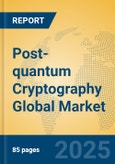Industry Characteristics
PQC architectures are defined by their mathematical diversity, blending lattice-based schemes for key encapsulation with code-based paradigms for error-resilient encryption, ensuring no single vulnerability undermines the ecosystem. Primitives like CRYSTALS-Kyber exemplify this, harnessing learning-with-errors problems for asymmetric security, while hash-based signatures like SPHINCS+ provide stateless resilience. The sector's hallmark is crypto-agility: modular designs permitting seamless algorithm swaps without infrastructural overhauls, vital for legacy migrations. Standardization bodies like NIST validate these through rigorous cryptanalysis, yielding FIPS-compliant hybrids that interweave classical and quantum-resistant layers. PQC's maturity manifests in optimized implementations - ASICs slashing latency by 50% - yet demands quantum-safe RNGs to thwart Grover-accelerated brute-forcing. Compared to legacy crypto, PQC's larger key sizes inflate bandwidth 2-4x, spurring compression innovations, but its post-quantum security proofs eclipse RSA's heuristics. In fintech and defense, PQC's forward secrecy thwarts retroactive breaches, while its auditability bolsters compliance. As quantum error correction matures, PQC evolves toward fault-tolerant hybrids, positioning it as the bedrock of secure quantum networks and distributed ledgers.Regional Market Trends
PQC's trajectory varies by region, mirroring cybersecurity maturity and quantum investments. North America's market growth is pegged at 18.0%-35.0% through 2030, led by U.S. dominance via NIST's standardization vanguard. Agencies like NSA mandate PQC migration by 2033, spurring federal contracts in defense, where lattice-based pilots secure classified comms. Canada's quantum hubs in Waterloo amplify R&D, with firms like evolutionQ pioneering hybrid chips.Europe's PQC ecosystem forecasts 17.0%-32.0% CAGR, anchored by ETSI's quantum-safe frameworks. Germany's BSI drives automotive adoption, embedding PQC in V2X protocols, while France's ANSSI enforces hybrid mandates in finance. The U.K.'s NCSC pilots code-based signatures for NHS data vaults, balancing GDPR with quantum resilience.
Asia-Pacific surges with 22.0%-38.0% growth, propelled by China's quantum supremacy ambitions. Singapore's IMDA certifies multivariate schemes for fintech, and India's CERT-In pilots hash-based PKIs for Aadhaar biometrics. Japan's NICT advances lattice hybrids for 6G trials, amid APAC's 60% share of global quantum patents.
Latin America's PQC uptake anticipates 16.0%-31.0% CAGR, with Brazil's ANATEL integrating quantum-safe VPNs for Petrobras pipelines. Mexico's IFT trials code-based e-voting, countering regional cyber threats.
MEA's market eyes 20.0%-36.0% expansion, with UAE's TRA piloting PQC for Dubai's smart grids. South Africa's SITA deploys multivariate for e-gov, leveraging mineral resources for quantum hardware.
Application Analysis
PQC's adaptability spans enterprise scales, with large enterprises commanding growth at 21.0%-37.0% CAGR to 2030, leveraging scale for bespoke hybrids in multicloud setups. Fortune 500s dominate, integrating PQC into zero-trust architectures for 80% of workloads. SMEs, surging at 19.0%-35.0%, embrace SaaS variants for cost-effective compliance, with 40% adoption in fintech startups shielding payment gateways.In large enterprises, PQC fortifies core infrastructures, from lattice-secured ERPs to code-based ledgers, slashing breach costs by 45%. Hybrid models blend classical fallbacks with quantum-safe upgrades, vital for global ops spanning GDPR and CCPA.
SMEs harness PQC's modularity for agile defenses, with multivariate signatures streamlining vendor portals. Cloud-agnostic libraries democratize access, enabling 25% risk reduction sans heavy R&D. Trends like zero-knowledge proofs amplify SME innovation in DeFi, where hash-based anonymity shields micro-transactions.
Company Landscape
IBM pioneers PQC with Quantum Safe Explorer, a toolkit dissecting crypto inventories for seamless migrations, dominating 25% market share via Watson-integrated hybrids. IBM's lattice expertise powers 5,000+ deployments, emphasizing crypto-agility for Fortune 1000s.PQShield excels in hardware-anchored PQC, with PQPlatform securing chips against side-channels; its Oxford roots yield 15% APAC traction in IoT.
ISARA Corporation's Catalyst suite blends quantum-safe certs with PKI, holding 12% enterprise share via automotive pilots.
Veridify Security's VerifAI fortifies ML models with code-based wrappers, carving 8% in edge computing.
QuSecure's QuProtect orchestrates PQC across clouds, with 10% growth in federal contracts.
QuintessenceLabs' Trusted Security Infrastructure delivers QRNG-secured keys, bolstering 7% in ANZ telecoms.
Rambus' root-of-trust modules embed hash signatures, commanding 9% in semiconductors.
NXP Semiconductors' A71CH integrates multivariate for automotive, with 11% EU dominance.
Thales Group's CipherTrust vaults PQC for data-at-rest, securing 13% in finance.
Entrust Corporation's eID fuses lattice with biometrics, growing 14% in identity management.
Industry Value Chain Analysis
PQC's value chain commences with algorithmic R&D, where academics and vendors like IBM forge resilient primitives. Hardware enablers - quantum RNGs from QuintessenceLabs - feed secure key generation, piped to middleware like PQShield's APIs for protocol wrapping. Core integration embeds PQC into stacks via ISARA's certs, culminating in enterprise deployment by Thales' vaults. End-users reap value through QuSecure's orchestration, with feedback loops refining via Entrust's audits. This chain balances innovation with interoperability, mitigating quantum risks across ecosystems.Opportunities and Challenges
PQC heralds opportunities in quantum-secure ecosystems, with hybrid protocols slashing migration costs by 40%. Regulatory tailwinds like NIST FIPS propel enterprise uptake, while SMEs leverage SaaS for agile defenses. Asia's 5G boom amplifies PQC in IoT, fostering $50B markets by 2030.Challenges abound in key bloat - lattice schemes inflating sizes 4x - straining bandwidth, demanding compression breakthroughs. Standardization silos risk fragmentation, urging ETSI-NIST convergence. Quantum side-channels loom, necessitating Veridify-like hardening, while talent scarcities hinder adoption.
This product will be delivered within 1-3 business days.
Table of Contents
Companies Mentioned
- IBM
- PQShield
- ISARA Corporation
- Veridify Security
- QuSecure
- QuintessenceLabs
- Rambus
- NXP Semiconductors
- Thales Group
- Entrust Corporation








